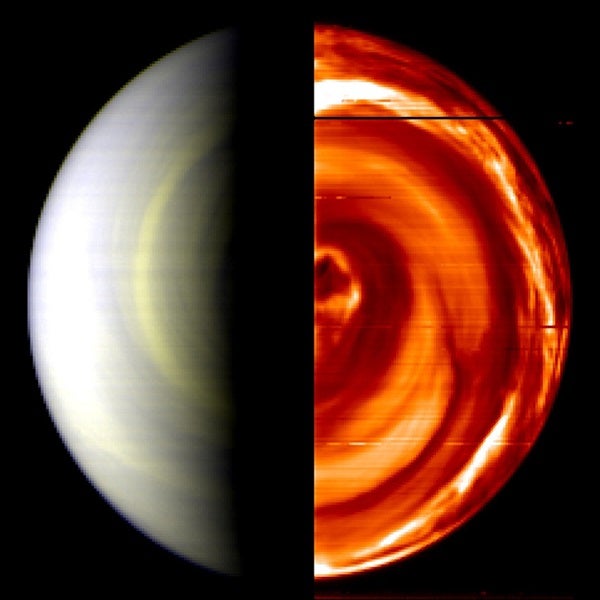The European Space Agency’s (ESA) Venus Express probe arrived at the planet only Tuesday. But even as the probe arced through its first orbit, eager scientists flexed the spacecraft’s instrumental muscles. Images released today show, for the first time, a dark atmospheric vortex at the planet’s south pole.
The views of Venus’ southern hemisphere, captured April 12 as the probe passed below the planet, are a first in space history. The images are at relatively low resolution because the spacecraft was farther from the planet than it will be once its orbit is adjusted, a process now underway. “We will … get over 100 times better resolution as we get closer to Venus,” says Venus Express project scientist Håkan Svedhem.
The probe’s Visual and Infrared Thermal Imaging Spectrometer (VIRTIS) nabbed the most intriguing image. It shows the planet’s night side through a 1.7-micron infrared filter. Reproduced in reddish false-color, the photo reveals spiral cloud structures in the lower atmosphere, about 34 miles (55 km) above the surface.
“We expect to see these spiral structures evolve very quickly,” Svedhem notes. Brighter regions correspond to areas with thinner cloud cover that allow thermal radiation to be imaged at lower altitudes.
A dark swirl of thick clouds appears almost directly over the south pole. Scientists know a similar polar vortex cloud structure exists over the planet’s north pole, and they suspected such a formation over the south pole as well. Venus Express has now confirmed its presence.
From the farthest point of the spacecraft’s initial orbit, Venus Express’ imagers can view the entire planet at once — something that won’t be possible once the probe reaches its final orbit. Planned engine and thruster burns during the next 16 orbits will bring the spacecraft closer to Venus. The probe is expected to attain its final 24-hour polar orbit May 7.










